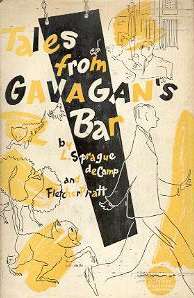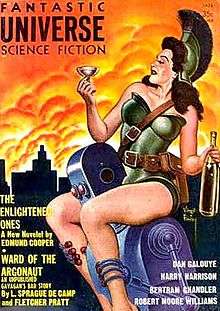Tales from Gavagan's Bar
 Dust-jacket for Tales from Gavagan's Bar | |
| Author | L. Sprague de Camp and Fletcher Pratt |
|---|---|
| Illustrator | Inga Pratt |
| Country | United States |
| Language | English |
| Genre | Fiction short stories |
| Publisher | Twayne Publishers |
Publication date | 1953 |
| Media type | Print (Hardback) |
| Pages | 228 pp |

Tales from Gavagan's Bar is a collection of short stories by science fiction and fantasy authors L. Sprague de Camp and Fletcher Pratt, illustrated by the latter's wife Inga Pratt. It was first published in hardcover by Twayne Publishers in 1953; an expanded edition retaining the original illustrations was published by Owlswick Press in 1978 and subsequently issued in paperback (without the illustrations) by Bantam Books in 1980. An E-book edition was published by Gollancz's SF Gateway imprint on September 29, 2011 as part of a general release of de Camp's works in electronic form.[1][2] The pieces were originally published between 1950 and 1954, mostly in The Magazine of Fantasy & Science Fiction.
The Gavagan's Bar stories fall into the genre of barroom tall tales, though in this instance most of the tall tales turn out to be true, or at least possibly true. The authors patterned them after Lord Dunsany's "Jorkens" stories.
Contents
Contents of the original edition:
- "The Gift of God"
- "Corpus Delectable"
- "The Better Mousetrap"
- "Elephas Frumenti"
- "Beasts of Bourbon"
- "The Love-Nest"
- "The Stone of the Sages"
- "Where To, Please?"
- "The Palimpsest of St. Augustine"
- "More Than Skin Deep"
- "No Forwarding Address"
- "When the Night Wind Howls" (retitled "Methought I Heard a Voice" in the expanded edition)
- "My Brother's Keeper"
- "A Dime Brings You Success"
- "The Rape of the Lock"
- "All That Glitters"
- "Here, Putzi!"
- "Gin Comes in Bottles"
- "The Black Ball"
- "The Green Thumb"
- "Caveat Emptor"
- "The Eve of St. John"
- "The Ancestral Amethyst"
Added in the expanded edition:
- "The Untimely Toper"
- "Oh, Say! Can You See?" (originally published as "Ward of the Argonaut")
- "Bell, Book, and Candle"
- "There'd Be Thousands in It"
- "One Man's Meat"
- "The Weissenbroch Spectacles"
- "By and About" (afterword)
Continuations
According to de Camp, he and Pratt envisioned at least one more Gavagan's Bar story, about a vampire with a sweet tooth, which was never written due to Pratt's early death.
While L. Sprague de Camp never continued the series on his own, an additional Gavagan's Bar story authored by Michael F. Flynn, "The Ensorcelled ATM", appeared in Harry Turtledove's 2005 tribute anthology honoring de Camp, The Enchanter Completed. It ties the series in with de Camp's later W. Wilson Newbury stories.
Critical reception
Reviewing the original edition for Galaxy, Groff Conklin described the stories as "completely enchanting -- wise, mad, fantastic, funny, warmly human and often very moving."[3] P. Schuyler Miller compared the stories to Lord Dunsany's "Jorkens" tales.[4]
References
- ↑ Orion Publishing Group's L. Sprague de Camp webpage
- ↑ Amazon.com entry for e-book edition
- ↑ "Galaxy's 5 Star Shelf", Galaxy Science Fiction, June 1954, p.121
- ↑ "The Reference Library", Astounding Science Fiction, August 1954, pp.151-52
- Laughlin, Charlotte; Daniel J. H. Levack (1983). De Camp: An L. Sprague de Camp Bibliography. San Francisco: Underwood/Miller. pp. 94–95.